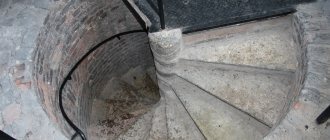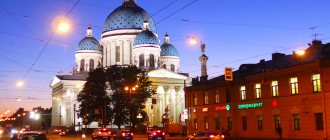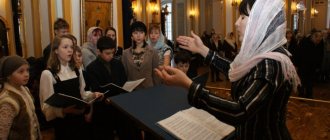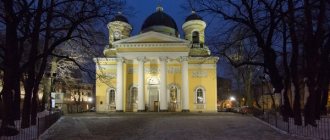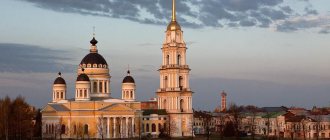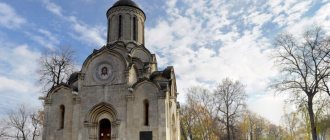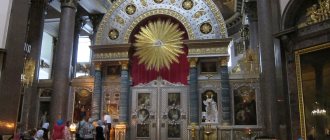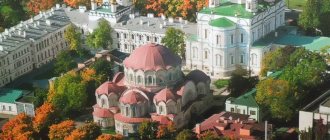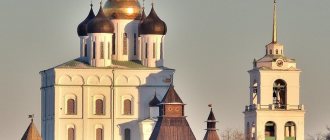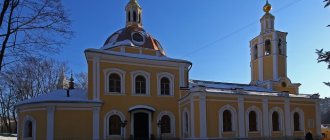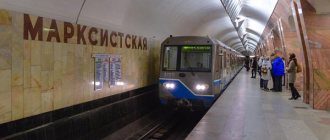My story will be about a majestic and at the same time unusually elegant temple, which is located on the left bank of the Neva, on Smolnaya Embankment. Its full name is Smolny Cathedral of the Resurrection of Christ. I personally have many solemn events in my life associated with him: I received the honorary badge of St. martyr Tatiana and several awards for victories in educational competitions.
Until 2015, the temple was familiar to St. Petersburg residents as a place for classical music concerts.
But now it has found its original true purpose, regaining its status as an Orthodox church. It is especially beautiful in winter, when its domes shine above the slender white-azure walls against the backdrop of snow-covered streets.
I will certainly mention the good traditions of the cathedral later, but for now I propose to get acquainted with the history of the appearance of this amazing architectural masterpiece in the Northern capital.
Description of the cathedral, exterior decoration
Smolny Cathedral is the center of the monastery complex. Churches are built around it on four sides , and the entire space of the architectural ensemble forms the shape of a cross.
Description of the Smolny Cathedral in brief facts and figures:
- author of the project - Bartolomeo Francesco Rastrelli (Winter Palace, Catherine Palace)
- architectural style – baroque
- date of foundation: 1748
- final finishing work - 1835
- the height of the cathedral is almost 94 meters
- number of domes - five
- capacity – about 6000 people
prya1707
aleksandra_sviridova
artiomstepnov
Corner churches are more reminiscent of palace buildings. They are connected by galleries of two-story residential buildings with rhythmically repeating arches in the facades. Blue walls under gilded domes and white stone stucco give the building a solemn appearance.
How to get there by public transport
The complex, designed by Rastrelli, is located at a decent distance from the metro, although it is located in the city center. If you need to get to the cathedral quickly and don’t have time to walk for half an hour, you can take the bus. The routes run regularly, so you won't have to wait long.
From the Chernyshevskaya metro station to the cathedral there are routes 22, 46 and trolleybus 15. From “Uprising Square” there are buses 22 and trolleybuses 7.5.
History of creation
Before the founding of St. Petersburg, on the left bank of the Neva, near its bend, there was the ancient village of Spasskoye. Under Peter I, by 1725, a large Smolny yard was built on this site, where resin was stored and tar was boiled for building ships.
was built next for the daughter of Peter the Great , Elizabeth, the future empress, who ascended the Russian throne in 1741. Here she spent her youth and here subsequently wanted to establish a monastery, which would include a temple, house churches, a bell tower and an institute for girls of noble birth. In 1744, there was a fire in the Smolny Palace , two years later it was dismantled , and the territory was cleared for new construction.
marmarisik
t_e_m
t_e_m
In 1751, when the preparatory work was completed and the foundations were installed, the actual construction of the cathedral began , generously financed from the state treasury. Thousands of soldiers and craftsmen worked every day to bring the project to life, construction progressed quite quickly.
But in 1757, Russia entered the Seven Years' War, which required the diversion of funding for military needs. Construction work slowed down, and after the death of Empress Elizabeth Petrovna in 1761, altogether .
Francesco Rastrelli returned to Italy in 1762. After his departure, Y. Felten , Rastrelli’s assistant in the construction of the Winter Palace, chief architect He worked in Smolny from 1765 to 1775 , which fell during the reign of Catherine II.
Meanwhile, the cathedral itself remained unfinished for almost 70 years, which gradually worsened its condition.
They continued to complete the construction of the temple only at the end of the 1820s by order of Emperor Nicholas I. They approved a revised project by the Russian architect Vasily Stasov , according to which:
- cleared the temple basements of water
- replaced damaged brickwork and roofing
- the dome was covered with zinc iron and painted azure with gold stars
- stove pipes were laid in the walls
- the columns were lined with white artificial marble
- installed marble steps and platforms for altars
- Sculptural decorations made according to drawings by Rastrelli himself were installed on the facade
The cathedral was consecrated in the name of the Resurrection of Christ in 1835
Bell tower and belfry
During the construction of the Smolny Monastery, Bartolomeo Rastrelli wanted to realize the project of the tallest 140-meter bell tower in Europe with five tiers. Its lower arch was supposed to serve as the main entrance to the monastery, the second tier as a gate church, and the four upper ones as a belfry. The construction of this gigantic structure had to be abandoned , and only a model remained Rastrelli’s plan , which is kept in the Academy of Arts.
During the completion of the cathedral in the city of Valdai, 12 bells and placed in the bell towers. At the request of Elizabeth Petrovna, the cathedral was built with five domes , but only one dome out of five relates directly to the temple. The remaining four are bell tower domes , in the lower tier of which the belfry is located.
Here is the highest observation deck in St. Petersburg, from which a panorama of the Neva bend, the Smolny ensemble, a view of the Bolsheokhtinsky Bridge, the Hermitage and other attractions opens up.
In 2013, a ten-ton bell was consecrated , delivered from Voronezh, where it was cast.
On the bell there are iconographic images created according to sketches by masters of St. Petersburg, and the names of the city's universities, cast in honor of the fact that the cathedral was considered a temple of educational institutions. The bell is awaiting installation near the gates of the Smolny Cathedral.
Observation deck
The observation deck of the Smolny Cathedral offers beautiful views of the residence of the Governor of St. Petersburg, Bolsheokhtinsky Bridge, Rastrelli Square, Kikiny Chamber Square, the ensemble of the Smolny Cathedral and other equally interesting sights.
The observation deck, located at an altitude of 50 meters, is considered one of the highest in the city; just below is the colonnade of St. Isaac's Cathedral.
There are 278 steps leading up, which are divided into 3 types, so the climb will not be boring. The ascent begins with ordinary staircase steps, similar to the front steps in apartment buildings.
At the height of 4 flights there is a gloomy attic room through which you need to go to a spiral stone staircase. Already starting from the attic, you feel as if you are in some ancient dungeon, there is a chill blowing in here and you can feel the humidity. The feeling is indescribable.
The next type of stairs immerses you in the atmosphere of a medieval castle and continues for only a couple of flights. If you look at the authentic walls of the temple and don’t lower your head along the way, then at the finish line you can meet a massive wooden beam. So you need to be careful.
Having overcome all the steps, a beautiful view of the historical part of St. Petersburg opens up, including the ensemble of most of the monastery. Particularly remote parts of the city can be viewed through free binoculars.
Standing with your back to the door, on the left you can see the Bolsheokhtinsky Bridge, the building of the Governor of St. Petersburg, and the Alexander Nevsky Church.
In the center you can contemplate the Church of St. Mary, the garden of the Smolny Cathedral, St. Isaac's Cathedral, and the building of the government of the Leningrad region.
On the right are the Church of Zechariah and Elizabeth, Rastrelli Square, Kikina Palata Square, Lakhta Center.
According to the official website of the Smolny Cathedral, the observation deck is open from 7 a.m. to 10 p.m. Payment is made in the form of a recommended donation - 200 rubles for adults and 100 rubles for schoolchildren, students and pensioners. At the checkout there is a terminal for paying with bank cards.
Advice! On the observation deck of the Smolny Cathedral the wind almost always blows and even in the heat you feel cool there. Therefore, it is better to stock up on a blanket or warm clothes.
menu
Improvement of the monastery territory
Architect Stasov, simultaneously with the redevelopment of the cathedral, completed the entire ensemble and landscaped the surrounding area. He created free passage to the cathedral and the city square, which was later named in honor of Rastrelli.
The architect covered the space around the monastery complex with a semicircular openwork fence, which became one of the most outstanding examples of highly artistic forging.
The perfection of proportions, the expressiveness of the decorative elements of the exterior decoration, gilded stucco molding and white columns make the temple a real pearl of Russian Baroque
Colonnade
The entrance to the territory of Smolny is decorated with columns - propylaea. They connect the Proletarian Dictatorship Square and the garden adjacent to Smolny.
Their project was developed in 1923. The columns of a simple, laconic form are an example of Russian classicism. Two rows of five columns, each forming covered galleries - porticos, placed on both sides of the entrance to the central alley of the garden.
The Smolny Propylaea became the prototype for columns in Moscow's Victory Park and some other places.
Garden
After the founding of the Smolny Monastery, the area adjacent to it was initially empty; a garden here in 1810 :
- paved paths covered with turf
- they poured fertile soil on which they planted trees
- installed a wooden fence
Over the subsequent years of its existence, the garden suffered greatly . re -developed from the mid-20s to the mid-30s of the last century. On the destroyed empty area in front of Smolny, flowers were planted and four fountains were built.
Now this garden is a monument of landscape art. On its central alley, surrounded by red flowers, stand monuments to Marx and Engels. In 2013, sakura bushes were planted in one of the garden sections, donated by the Japanese royal family for the next anniversary of St. Petersburg.
Entrance to the garden is free, anyone can visit it
Interior decoration and shrines of the cathedral
The interior of the church hall was also designed by Vasily Stasov :
- lined with snow-white artificial marble
- multiple stucco decoration is designed in the form of angelic faces, flower garlands, palm and olive branches, sea shells
- three iconostasis installed
- The church pulpit is framed with exquisite carvings
- the fence in front of the altars is a balustrade, made of cut crystal
masteryonok_ermak
umbram_catiline
streamersx
ivan___parhomenko
lina_popova_life
tanais7788
gavrilova3429
Before the abolition of the cathedral during the years of Soviet power, he owned valuable icons:
- Chernigov Mother of God, whose image was painted in a robe with precious stones
- Reliquary icon of the Savior Not Made by Hands
- images of the Kiev-Pechersk wonderworkers
All icons and valuable items of interior decoration were looted after the cathedral was closed in the 20s of the last century. Now among the relics in the Smolny Cathedral there are icons painted by the Russian painter Alexei Venetsianov :
- Resurrection of Christ
- Presentation of the Blessed Virgin Mary into the Temple
History of existence
Throughout its existence, the Smolny Cathedral played different roles.
teaching temple
From 1764 to 1917, the Institute of Noble Maidens, the first women's educational institution in Russia , operated within the walls of the Smolny Monastery Immediately after its founding, under Empress Catherine II, the successor of Elizabeth Petrovna, the institution was called the “Imperial Educational Society for Noble Maidens.”
In 1796 Maria Feodorovna , wife of Paul I, took it under her authority founding the charitable Department of Institutions. In 1806, was built for the pupils - the Smolny Institute , which became another part of the monastery complex.
By order of Nicholas I, the erected Smolny Cathedral became the temple of educational institutions. In memory of its illumination, a medal was cast with the image of the cathedral and the image of Christ blessing the children.
On the altar wall were indicated the names of educational institutions that were part of the Department established by Maria Fedorovna. Students took part in annual ceremonial services.
Nowadays, the buildings of the monastery complex house branches of various higher educational institutions of St. Petersburg
Concert hall
For 25 years, the Smolny Cathedral was a venue where annual concerts of instrumental music were held. In 1990, a concert and exhibition hall was organized here , and light and music equipment was installed. In 2010, an electronic organ appeared , and organ concerts became the hallmark of the cathedral . The last one was given in January 2016.
In 1991, a chamber choir was organized at the cathedral , whose members are students and graduates of the St. Petersburg Conservatory.
The concert activities of the group include:
- participation in music festivals in Russia and Europe
- trips to Russian cities for anniversary celebrations
- charity concerts on anniversaries marking the beginning and end of the siege of Leningrad
The permanent venues for the choir's performances are the halls of the St. Petersburg Philharmonic and the Mariinsky Theater, as well as the churches of St. Petersburg: St. Isaac's Cathedral, Church of the Resurrection of Christ, Feodorovsky Cathedral
Its repertoire includes choral works with a 500-year history - liturgical chants, requiems, masses written by the greatest composers:
- Bach
- Beethoven
- Mozart
- Tchaikovsky
- Rachmaninov
The group began to be called the Concert Choir of St. Petersburg in 2016, after it ceased to exist at the Smolny Cathedral
Spiritual abode
The monastery finally abolished in 1797, after the death of the last nun. And in the Smolny Cathedral of the monastery complex, divine services were performed for almost 90 years. A few years after the October Revolution and the overthrow of the tsarist government, in 1922, the cathedral was closed, confiscating all church valuables.
In 2016, it again became an active Orthodox church - it was transferred to the jurisdiction of the Church. But regular services began to be held there since 2010. The first Divine Liturgy was celebrated in the cathedral on April 7, 2010, on the Feast of the Annunciation.
Divine services
- 07:00 daily morning Liturgy
- 16:00 evening service
Other church sacraments are also performed in the cathedral - Baptism and Wedding, and a children's Sunday school operates.
In addition, on the day of remembrance of the holy martyr Tatiana, who in Russia is considered the patron saint of students, a solemn service is held in the Smolny Cathedral, followed by the presentation of awards to students who excel in spiritual and moral education
Concert Choir of St. Petersburg
In 1991, a chamber choir was created, which was organized on the basis of the concert and exhibition hall. It received the name of the Chamber Choir of the Smolny Cathedral. When the cathedral was transferred to the church, the choir changed its name because it lost its meeting place. Since 2016, it has been named the Concert Choir of St. Petersburg.
The choir, headed by Vladimir Begletsov, spent a long time looking for a new location, and, in the end, it was offered a hall in the building of the pre-revolutionary City Duma on Nevsky Prospekt.
Legends and secrets
When approaching the Smolny Cathedral, you can notice an optical illusion: a tall temple, directed into the sky, as if it goes into the ground. In addition, the cathedral keeps several more secrets.
"Unclean" place
Even before the founding of St. Petersburg, the site of the future construction of Smolny was considered the “Devil's Bank” , and the residents who lived here had the reputation of communicating with evil spirits. An interesting fact is that Peter I ordered the construction of the Smolny Yard here and the storage of resin, which is associated with the biblical hell.
Ghosts
In Soviet times, the ghosts of a Smolyanka girl and a monk were encountered here , whom a KGB officer guarding the Security Committee archive located here could not kill with pistol shots. And also some see the ghost of a pharmacist who lived near the cathedral. When preparing his potions, he used the blood of pigeons that he caught in the belfry of the Smolny Cathedral. One day, an accident occurred: the pharmacist fell from a height, falling to his death. Since then, his ghost, stalking the birds, can sometimes be seen in the belfry.
Underground bunker
During restoration work in Smolny, long were found . This discovery marked the beginning of the legend that a metro line was built from the basements of Smolny to evacuate government officials from Leningrad. The first in the city was organized right under the Smolny Cathedral.
"There is no cross on it"
During the summer hurricane 2002, on the dome of the cathedral was broken by a lightning strike and stuck into the roof. The townspeople again remembered all the mystical stories associated with this historical place: after all, the cross was torn down only on the Smolny Cathedral, despite the large number of them in the city.
Mysticism of numbers
By a strange coincidence, the history of the creation and existence of the Smolny Cathedral is connected with one figure:
- It took 87 years to build it
- Church services were held there for 87 years after its opening.
- after 87 years, the first prayer service was held since the closure
Those who believe in the magic of numbers identify eight with a shield and seven with a sword, believing that the cathedral stands to protect the city.
Visiting information
You can find the Smolny Resurrection Cathedral, the history of which is associated with many mystical legends, in the center of St. Petersburg on Rastelli Square.
Metro and ground transport
However, it is not possible to get to the square using the metro: the cathedral is located approximately 2 km from the nearest metro station Chernyshevskaya.
Therefore, it is optimal to order a taxi from the center or from Chernyshevskaya.
But in general, you can complicate your life and wait for a bus or minibus.
The following stops are located directly on the square :
- minibus No. K 46, K 76
- bus number 136
buses No. 46, 54, 74 stop the Proletarian Dictatorship Square stop, a 4-minute walk from the cathedral
Opening hours and cost of visiting
The cathedral is open to the public from 07:00 to 20:00.
During the same hours you can visit the observation deck at the cathedral belfry. To do this, it is recommended to make a donation of 150 rubles. Visits for students and pensioners are free.
Excursions
- On Saturdays and Sundays, excursions are held in the cathedral, the cost of which for each tourist, except students and pensioners, is 200 rubles.
- In addition, children's educational adventure games are held - quests , during which children get acquainted with the history of the Smolny Cathedral. The cost of participation in the quest is also 200 rubles.
The collected donations go towards the restoration of the temple, which began after its transfer to the department of the Church. Here it is planned to recreate historical interiors.
Interior
The interior of the Smolny Cathedral amazes with its originality and beauty from the very entrance. Above the tall and massive entrance door hangs an icon of Jesus Christ, which is surrounded by elegant hand-carved wood.
Entering inside, the amazing scale of the room opens up, which is difficult to imagine from the outside.
White walls with bas-reliefs, golden rocailles, massive marble columns, wide galleries along the edges, and a high domed sky in the center (unfortunately, at the time of writing, this place is under restoration).
And this entire large-scale space is filled with sculptures, icons (some of them periodically stream myrrh) and other rich church utensils.
menu
